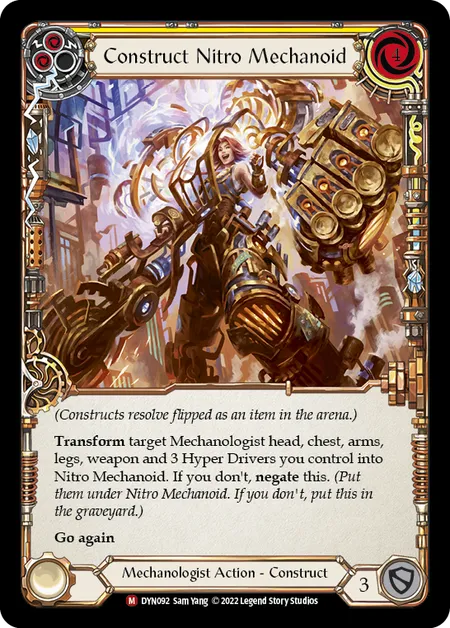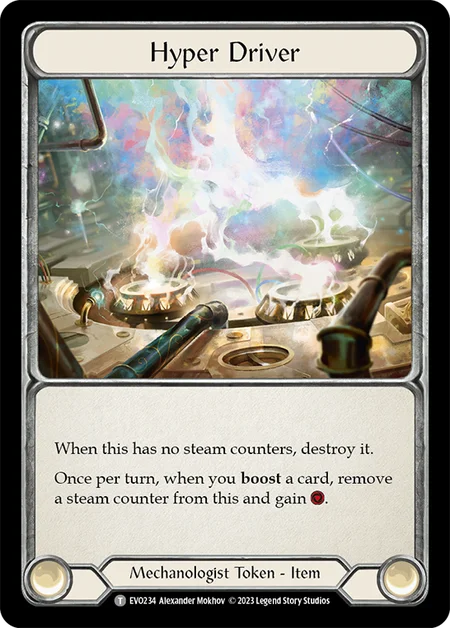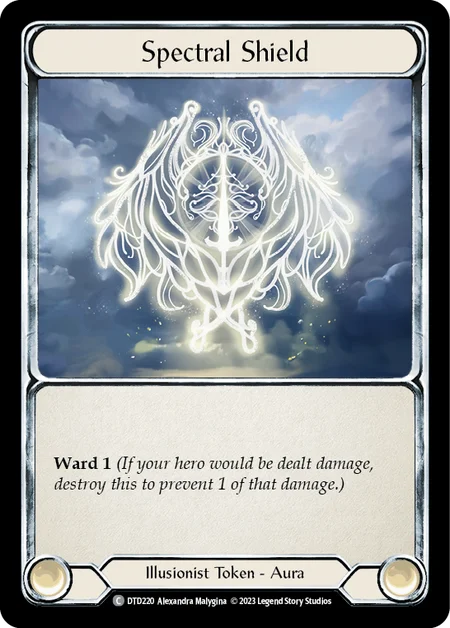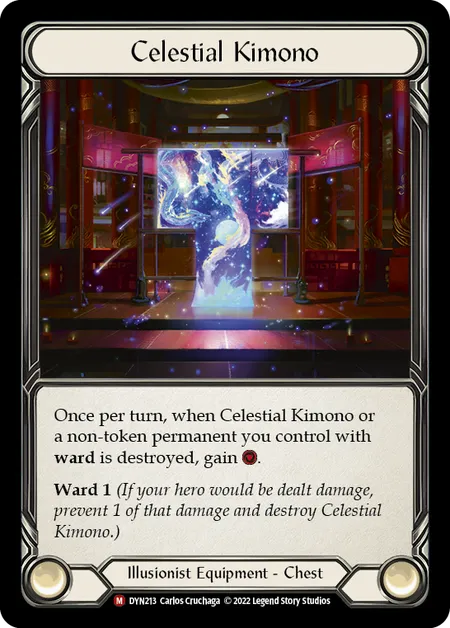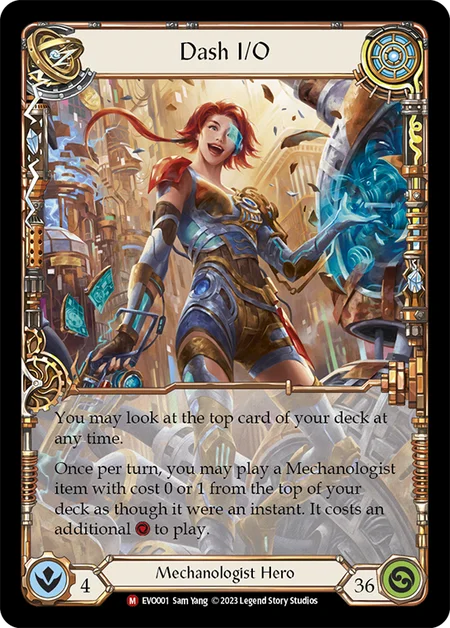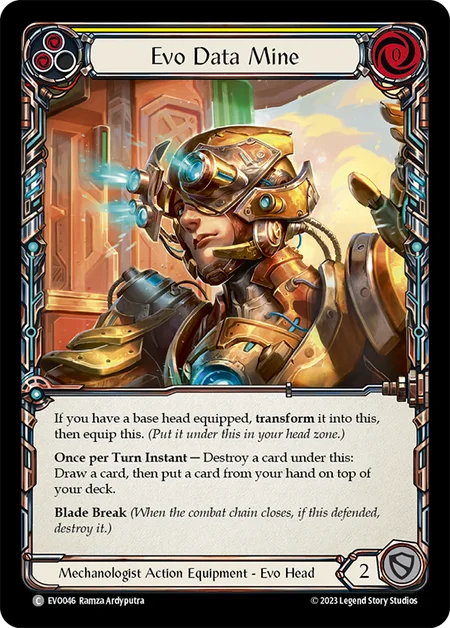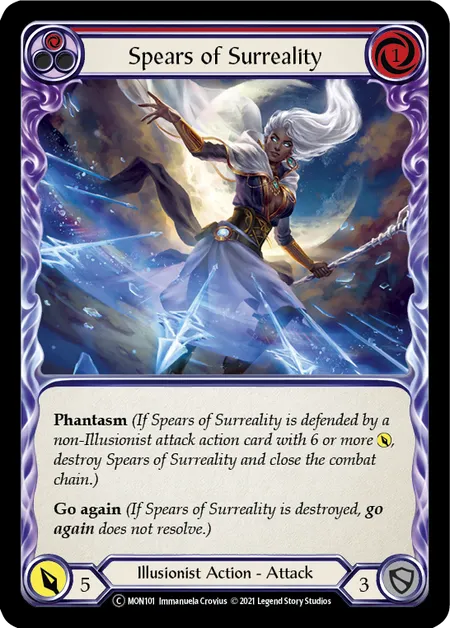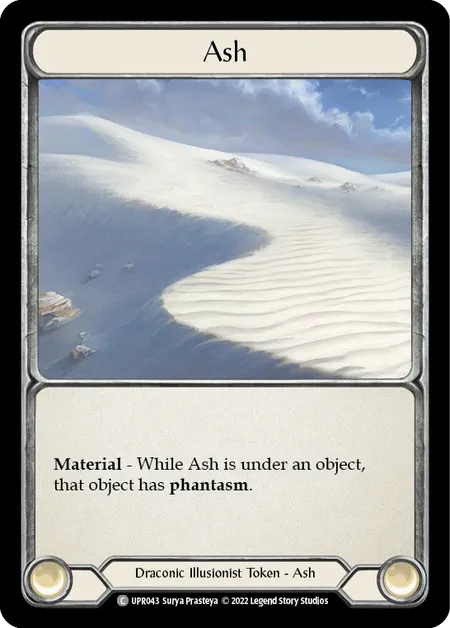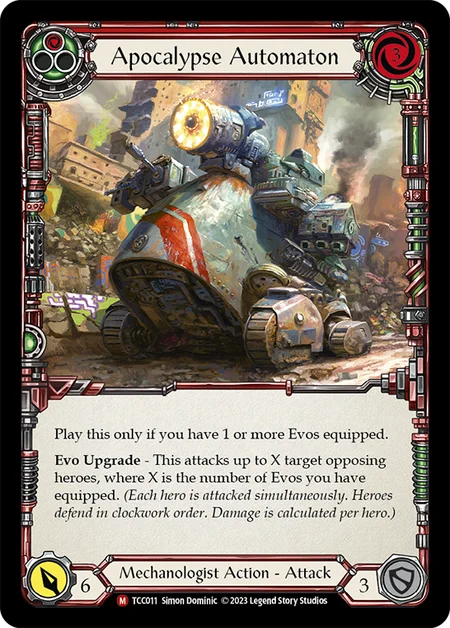With Bright Lights and Round the Table come quite a lot of new mechanics and interactions, and we have taken the time to explore how these are integrated into our comprehensive rules. We've also made updates to our rules and policy regarding tokens, triggers, looking at cards with Dash I/O, phantasm, Ultimate Pit Fight, and tardiness at competitive events.
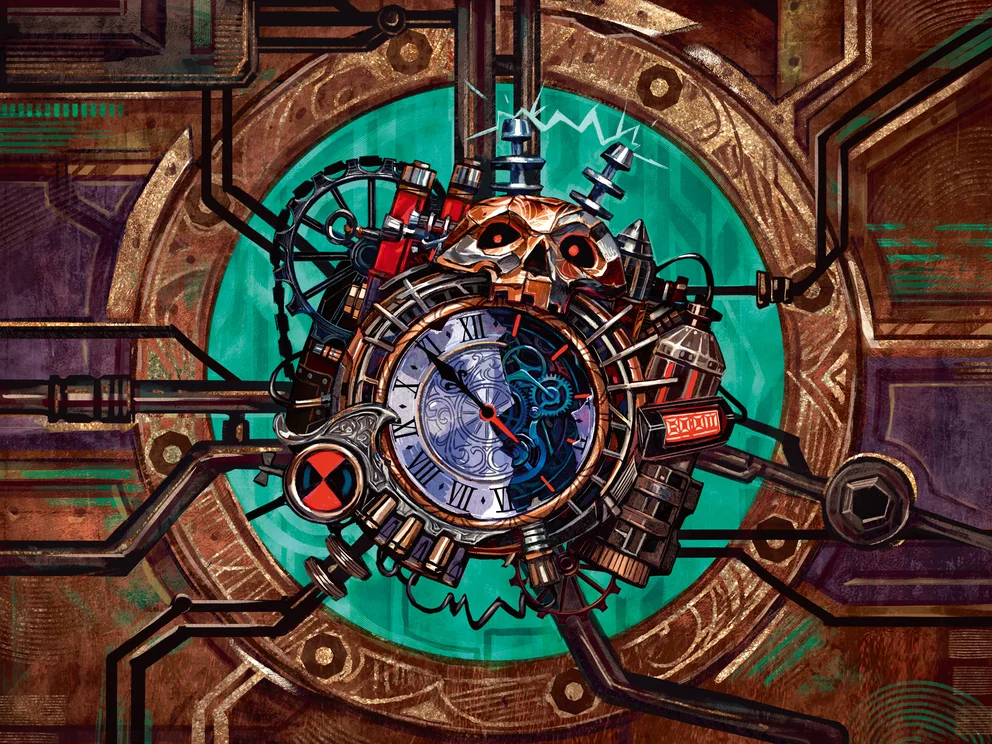
Tokens are cards
In previous iterations of the Comprehensive Rules, tokens were described as a permanent in the arena that is not a card. With the expansion of interactions that involve transforming cards and future design space to consider, it is a natural move for the game of Flesh and Blood to have tokens represent temporary cards instead of being a separate entity altogether.
This change affects very few existing interactions in the game and primarily affects interactions with the new Hyper Driver token and Phantom Tidemaw card. Specifically, Hyper Driver tokens are considered cards when under other objects such as Nitro Mechanoid, which empowers heroes like Maxx to be able to utilize their hero ability to the full extent. Phantom Tidemaw also gets a buff, by allowing Spectral Shields to trigger its ability when they are destroyed.
However, it is very important to make a distinction between token-type, and token-rarity. Token-type cards (a.k.a. tokens) have the word “token” written in the type box of official Flesh and Blood cards. Token-rarity cards have either a “-T” after their card code or a token-rarity symbol on them. There is some overlap (some token-type cards are token-rarity), but there are no interactions in the game that are dependent on the rarity of a card (only deck-building restrictions, such as that of Commoner).
The behavior of tokens will not change from this update. Tokens (the type, not the rarity) can not be included in the card-pool of a player, they can only be created by effects, and they cease to exist when they leave the arena. A card like Crouching Tiger is unaffected by any of these changes because it was always considered a card, not a token.
Tyler controls 3 Hyper Driver tokens, 4 Mechanologist equipment, and 1 Mechanologist weapon. Tyler plays and successfully resolves Construct Nitro Mechanoid transforming their permanents into Nitro Mechanoid (including the 3 Hyper Driver tokens). Tyler then attacks Nic with Nitro Mechanoid, banishing a Hyper Driver token from underneath it to pay the cost.
Players order their own triggers
After a review of how multiple effects trigger, we have decided to revisit how players may choose to order triggered layers on the stack. When multiple effects have been triggered, and a player gains priority, there are two or more triggered layers that need to be resolved in a certain order. Previously this order was determined by the turn-player, which gave them a lot of control over the order of their opponent's triggers.
The new change allows the turn-player to pick if their triggers will resolve first, or their opponents, and then each player gets to order their own triggers. This is similar to how replacement effects are ordered, creating a more unified structure for the decision-making process of how to order otherwise simultaneous effects.
In short, this is how it works:
- If there are two or more triggers (controlled by different players) and it’s your turn, you pick whose triggers go on the stack first.
- If you control two or more triggers, you choose the order they go on the stack.
This change fundamentally affects the interactions of cards like Celestial Kimono and Diadem of Dreamstate, and allows the controlling player to access the full synergy of these cards. The turn player still has some advantage, allowing them to choose whose triggers resolve first. There are other minor edge cases outside of this interaction, but this change will otherwise not affect typical gameplay.
Nic controls both Celestial Kimono and Diadem of Dreamstate. Tyler attacks Nic with Frost Fang (red), Nic prevents 3 damage (with ward 1 and ward 2), and takes 2 damage. There are 3 triggered layers that need to be put onto the stack: Tyler’s Frost Fang trigger, and Nic’s Celestial Kimono and Diadiam of Dreamstate triggers. Tyler is the turn player and decides that they want their trigger to resolve first, so Nic must put their triggers on the stack first (remember that layers resolve from top to bottom). Nic puts Diadem of Dreamstate trigger at layer 1, then Celestial Kimono trigger at layer 2, and then Tyler puts the Frost Fang trigger at layer 3. Layer 3 resolves first, and Nic chooses not to pay and discards a card. Layer 2 resolves next, and Nic gains 1 resource. Layer 1 resolves last, and Nic chooses to pay 1 resource to create a Ponder token.
Looking at cards with Dash
One of the challenges of the newest set Bright Lights is the granularity of the rules. As we delve further into more complicated interactions, larger simultaneous processes we take for granted need to be refined and broken down into ordered steps so we can make clear and consistent rulings.
The new Dash I/O’s ability (and her younger counterpart Dash, Database) allows the player to look at the top card of their deck at any time. This ability is more nuanced than it seems at first glance as there are many instances where the top card changes as a part of a rule or effect. The situation we want to avoid with this ability is allowing players to see the second top card of their deck when an effect is incomplete and using that information to inform future decisions of the effect, such as when halfway through playing a card, resolving an effect, or even when shuffling. As such, when a card is determined by a location for a “look” effect (e.g. look at the top of your deck), it is reevaluated only when a player would gain priority. Note that this happens before you add triggered layers to the stack, meaning you have the ability to gain information before choosing how to order your triggers
While playing Dash I/O, you can always look at the top of your deck as though it were a card like in your arsenal - you don’t have to wait to gain priority to look. However, if you’re half-way through a process for a rule or effect, and the top card of the deck changes, then you can’t look at the new top of your deck until that action has been completed and a player gains priority again. This includes shuffling and presenting during the start-of-game procedure.
Here are some examples of when you can and can’t look at the top of your deck:
- Tyler is playing as Dash I/O. Tyler looks at the top of their deck, which is a Mechanologist item with cost 1, and decides to play it. First, they announce the card by putting it onto the stack. Because the top card of Tyler’s deck has changed but no player has gained priority yet, Tyler may not look at the new top card of their deck. Second, Tyler chooses any targets, modes, etc.) and pays any costs. Finally, the card is considered played, Tyler regains priority, and may now look at the new top card of their deck.
- Tyler is playing as Dash I/O and controls Evo Data Mine. Tyler activates and resolves Evo Data Mine. First, Tyler draws a card. Because the top card of Tyler’s deck has changed but no player has gained priority yet, Tyler may not look at the new top card of their deck. Second, Tyler chooses to put a card from their hand on top of their deck. Finally, the layer has finished resolving, Tyler regains priority, and may now look at the new top card of their deck.
- Tyler is playing as Dash I/O and has boosted this turn. Tyler plays and resolves Spark of Genius. First, Tyler searches for a Mechanologist item in their deck and puts it into the arena. If the item has crank (or a similar replacement effect), Tyler chooses to apply those now. Second, Tyler shuffles their deck. Because the top card of Tyler’s deck has changed (and is changing) but no player has gained priority yet, Tyler may not look at the new top card of their deck. Third, Tyler draws a card from Spark of Genius. Finally, the card is considered resolved, Tyler regains priority, and may now look at the new top card of their deck. If there are any triggered-layers to be put on the stack, Tyler may look at the new top card of their deck before choosing any modes or targets for that triggered-layer before it is put on the stack, or before choosing the order that those layers are put onto the stack.
Phantasm only closes the chain if the attack has not resolved
Phantasm was originally ruled using its reminder text developed in Monarch:
Phantasm (Whenever this is defended by a non-Illusionist attack action card with 6 or more [power], destroy this and close the combat chain.)
It is important to note that reminder text is not rules text. Its purpose is to help guide players to the most intuitive understanding of a card, deviating from the exact rules text when necessary to achieve this goal. During the development of the Comprehensive Rules 2.0, phantasm was encoded explicitly from this reminder text, rather than its original intent. This has led to an optimal play-pattern of closing the combat chain after every attack, to ensure that phantasm on previous chain links do not trigger and close the combat chain when the player has already spent additional resources to continue attacking. This has become even more relevant with the rise of cards like Art of War making their way into popular decks and being used defensively to trigger phantasm on the attacker’s cards.
As such, we’ve decided to reevaluate phantasm and rule it closer to its original design:
Phantasm (Whenever this is defended by a non-Illusionist attack action card with 6 or more [power], destroy this.)
In short, if you trigger and resolve phantasm on an attack:
- If the chain link has not been resolved (i.e. before the damage step), the combat chain will close.
- If the chain link has resolved (i.e. after the damage step, or on a previous chain link), the combat chain will not close.
Note that this is not an errata for cards with phantasm. The reminder text will remain the same because reminder text is not rules text - it’s there to help players (especially newer players) understand the most common interactions of the ability.
There are still cases where you might want to close the combat chain (e.g. attacking with an ally that you don’t want to be destroyed on a previous chain link), but we hope that this change leads to a more intuitive, optimal play-pattern for high-level Illusionist players in general and a better viewing experience for spectators.
Tyler attacks Nic with Spears of Surreality and Nic defends with an attack action card with 5 power (chain link 1). The chain link resolves and Tyler attacks Nic again with another Spears of Surreality. This time Nic plays and resolves Art of War, choosing the first and third modes (Attack action cards you control gain +1 defense and +1 power this turn, and Until end of turn, you may defend with attack action cards from arsenal). The attack action card defending on chain link 1 is now at 6 power, triggering phantasm, and destroying the first Spears of Surreality. However, the combat chain does not close because that attack has already been resolved, the attack simply gets destroyed and goes to the graveyard.
Ultimate Pit Fight rules updated for Round the Table
To accommodate the latest set of rule-breaking cards from Round the Table: TCC x LSS, the Comprehensive Rules is getting a massive update, but we’re also updating the rules for Ultimate Pit Fight (UPF). Specifically, the rules that allow you to only target players to your left or right will be updated as follows:
You may only target heroes and objects controlled by those heroes to your immediate left or right (for attacks, or with effects that say “target”), with the following exceptions:
- If an effect explicitly allows you to target any hero, you may target any live hero in the game.
- If an effect explicitly targets 2 or more heroes, you may target any live hero in the game.
- If an effect allows you to change the target of an attack/effect, you may choose any legal target for the attack/effect.
This allows for an expanded design space where cards can be specifically targeted towards social play and the fun that comes with breaking the tenets of the game occasionally.
Tardiness across Competitive and Professional REL
One of the challenges as both a judge and a player is understanding the nuances of tournaments that you attend, especially with the differences between the competitive and professional rules enforcement levels (RELs). In particular, we’ve updated the rules regarding the timeliness of players (and the infraction of tardiness) to be unified across these RELs and clarified the expectations and repercussions of decklist submission.
Here are the new recommended timings and penalties for tardiness for both Competitive and Professional:
- Less than 1 minute: Warning
- Less than 10 minutes: IP2
- 10 or more minutes: Game Loss
Tardiness is evaluated from the time that the round timer starts and the round timer should be started when players have been given sufficient time to be seated and ready. A downgrade to a warning (for less than 1 minute tardy) has been introduced to allow for some amount of leeway for logistics at larger tournaments where players just miss the mark for the round timer starting, or where judges can’t see the player making the way to their seat.
It’s important to note that the start-of-game procedure is incorporated into the round time. Players may begin the first start-of-game procedure before the round timer starts but may not start playing their first game until the round timer starts. Once the round timer has started, players should finish the first start-of-game procedure within 5 minutes. Players are still considered tardy if they are not seated when the round timer starts, even if it’s within these 5 minutes.
Tardiness time extensions should be given relative to when the round starts. If a player arrives at their table 3 minutes after the round timer starts, the table should be given 3 extra minutes to complete the round, even if other tables had begun their start-of-game procedure before the timer started.
In addition, if a format requires decklist submission, a player is considered tardy if they have not submitted their decklist on time and may not play games until they’ve submitted their decklist.
Tyler is a player at a Competitive REL tournament. Tyler is talking with their friends and the pairings for the next round are announced. Tyler does not move and keeps talking for a while longer, and then the round timer begins. Tyler rushes to their table and their opponent, Nic, is already seated. Tyler is issued a warning for arriving less than 1 minute late to their assigned table.
